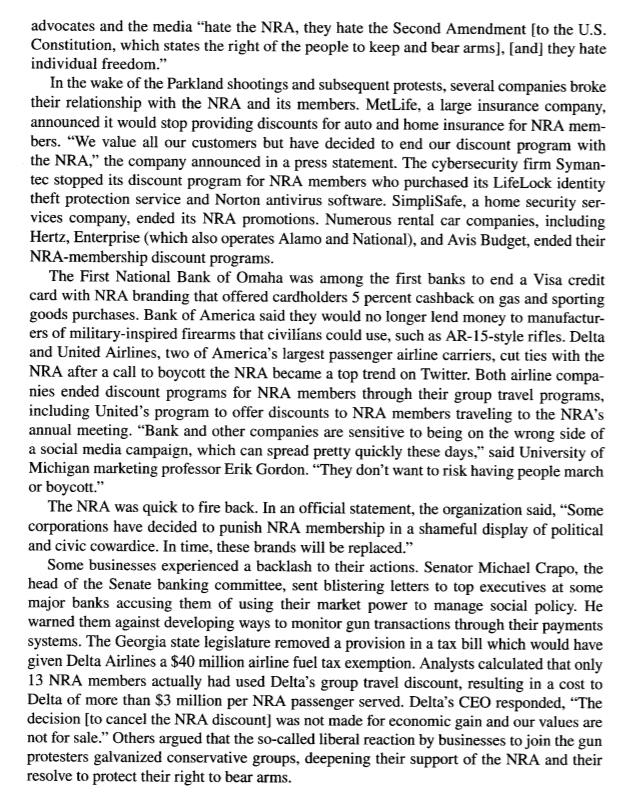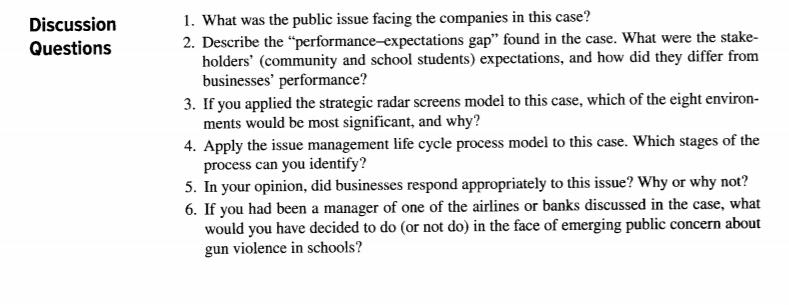Answered step by step
Verified Expert Solution
Question
1 Approved Answer
The quiet community of Parkland, Florida, was rocked in 2018 when a 19-year-old former student entered Marjory Stoneman Douglas High School with a duffel



The quiet community of Parkland, Florida, was rocked in 2018 when a 19-year-old former student entered Marjory Stoneman Douglas High School with a duffel bag containing an AR-15-style rifle, a vest with additional magazines for the weapon, and a semi-automatic version of the M16 rifle used by the U.S. military. Within minutes, he had shot and killed 17 people, and the nation mourned another tragic school shooting. In response, Parkland students launched the #NeverAgain movement and protested con- tinuing gun violence, especially in schools; the lack of gun control measures; and a mental health system that had allowed someone with a troubled history to purchase an assault rifle. A month later hundreds of thousands of people-children, parents, politicians, and celebrities-gathered for "The March For Our Lives" in Washington, DC, jamming onto Pennsylvania Avenue from the White House to the U.S. Capitol in what may have been the biggest rally for tighter gun control in American history. Other similar marches and pro- tests were held that day in nearly every major U.S. city. Many called on Congress to take action and pass strict gun control legislation, as had also occurred after prior mass shooting incidents in Las Vegas, Newtown, Orlando, and other cities and towns. Some protesters simply called for a ban on assault rifles and more thorough back- ground checks for gun purchasers. Others specifically targeted the National Rifle Asso- ciation (NRA), an advocacy organization that had vigorously opposed any restrictions on gun ownership. In response to the Parkland students, NRA's CEO Wayne LaPierre told an audience at the Conservative Political Action Conference that "as usual the opportunists wasted not one second to exploit tragedy for gain," adding that gun control advocates and the media hate the NRA, they hate the Second Amendment [to the U.S. Constitution, which states the right of the people to keep and bear arms], [and] they hate individual freedom." In the wake of the Parkland shootings and subsequent protests, several companies broke their relationship with the NRA and its members. MetLife, a large insurance company, announced it would stop providing discounts for auto and home insurance for NRA mem- bers. "We value all our customers but have decided to end our discount program with the NRA," the company announced in a press statement. The cybersecurity firm Syman- tec stopped its discount program for NRA members who purchased its LifeLock identity theft protection service and Norton antivirus software. SimpliSafe, a home security ser- vices company, ended its NRA promotions. Numerous rental car companies, including Hertz, Enterprise (which also operates Alamo and National), and Avis Budget, ended their NRA-membership discount programs. The First National Bank of Omaha was among the first banks to end a Visa credit card with NRA branding that offered cardholders 5 percent cashback on gas and sporting goods purchases. Bank of America said they would no longer lend money to manufactur- ers of military-inspired firearms that civilians could use, such as AR-15-style rifles. Delta and United Airlines, two of America's largest passenger airline carriers, cut ties with the NRA after a call to boycott the NRA became a top trend on Twitter. Both airline compa- nies ended discount programs for NRA members through their group travel programs, including United's program to offer discounts to NRA members traveling to the NRA's annual meeting. "Bank and other companies are sensitive to being on the wrong side of a social media campaign, which can spread pretty quickly these days," said University of Michigan marketing professor Erik Gordon. "They don't want to risk having people march or boycott." The NRA was quick to fire back. In an official statement, the organization said, "Some corporations have decided to punish NRA membership in a shameful display of political and civic cowardice. In time, these brands will be replaced." Some businesses experienced a backlash to their actions. Senator Michael Crapo, the head of the Senate banking committee, sent blistering letters to top executives at some major banks accusing them of using their market power to manage social policy. He warned them against developing ways to monitor gun transactions through their payments systems. The Georgia state legislature removed a provision in a tax bill which would have given Delta Airlines a $40 million airline fuel tax exemption. Analysts calculated that only 13 NRA members actually had used Delta's group travel discount, resulting in a cost to Delta of more than $3 million per NRA passenger served. Delta's CEO responded, "The decision [to cancel the NRA discount] was not made for economic gain and our values are not for sale." Others argued that the so-called liberal reaction by businesses to join the gun protesters galvanized conservative groups, deepening their support of the NRA and their resolve to protect their right to bear arms. 1. What was the public issue facing the companies in this case? 2. Describe the "performance-expectations gap" found in the case. What were the stake- holders' (community and school students) expectations, and how did they differ from businesses' performance? 3. If you applied the strategic radar screens model to this case, which of the eight environ- ments would be most significant, and why? 4. Apply the issue management life cycle process model to this case. Which stages of the process can you identify? 5. In your opinion, did businesses respond appropriately to this issue? Why or why not? 6. If you had been a manager of one of the airlines or banks discussed in the case, what would you have decided to do (or not do) in the face of emerging public concern about gun violence in schools? Discussion Questions
Step by Step Solution
★★★★★
3.40 Rating (141 Votes )
There are 3 Steps involved in it
Step: 1
As per the case study insecurity is one of the major issues most of the companies face Security is important as well as key in the safety and well being of the public The companies have also been affe...
Get Instant Access to Expert-Tailored Solutions
See step-by-step solutions with expert insights and AI powered tools for academic success
Step: 2

Step: 3

Ace Your Homework with AI
Get the answers you need in no time with our AI-driven, step-by-step assistance
Get Started


